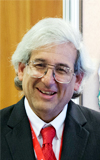HyperWall exhibition is scheduled at the poster room in JpGU2014. This event is collaboration between NASA and JAXA. You can see recent satellite observation results on the huge display, as large as 4m x 2.5m. Frontier scientists from NASA and JAXA give lectures of their satellites. You are welcome to join and ask questions!

Greetings from Organizers
Michael Freilich (Earth and Science Division Director/NASA)

Like all things in life, Earth’s environment is in a constant state of flux. Components of the Earth system — including the atmosphere, hydrosphere, lithosphere, cryosphere, and biosphere — are all connected, and interact in complex ways that we do not fully understand. At NASA, our goal is to study the Earth as a system and understand how both natural and human-induced changes impact Earth’s environment over time.
For nearly 30 years NASA has been collecting, archiving, researching, and disseminating a broad spectrum of satellite-based Earth-observation datasets. Over the coming decades NASA will be able to deliver even more crucial data to the scientific community so that societies can meet the challenges of the future.
For nearly 30 years NASA has been collecting, archiving, researching, and disseminating a broad spectrum of satellite-based Earth-observation datasets. Over the coming decades NASA will be able to deliver even more crucial data to the scientific community so that societies can meet the challenges of the future.
Masaki Fujimoto (Vice-chairman of JpGU International Science Committee, Vice of International Coordination of Space Science in ISAS/JAXA)

We are happy to announce that there will be NASA-JAXA collaboration in outreach activities at the coming JpGU meeting. Big goals in space and earth sciences are shared commonly among scientists all over the globe. Indeed JAXA and NASA have collaborated on spacecraft missions in space and earth sciences. It is only natural to collaborate in outreach activities that demonstrate to to the public the benefits from the space missions. I believe collaboration leads to something that would have been unreachable otherwise. We look forward to Japanese scientist presentations using NASA's HyperWall presentation system. Through this outreach activity, the audience can see not only the applications from our international collaboration missions, but also how international collaborations are developed.
Timetable
* Presentation time includes 5 minutes for Q&A.
4/28 Mon.
| 18:15 - 18:45 | Michael Freilich | NASA's View of Earth from Space |
| 18:45 - 19:15 | Masaki Fujimoto | JAXA Space Science |
4/29 Tue.
| 15:30 - 15:45 | Michael Freilich | Looking Down on the Earth: How Satellites Have Revolutionized Our Understanding of Our Home Planet |
| 15:45 - 16:00 | Dalia Krischbaum | The Global Precipitation Measurement (GPM) Mission: Advancing precipitation measurement for science and society |
| 16:00 - 16:15 | Yukari Takayabu/ Riko Oki | Measure rain and snow for the benefit of all. "Global Precipitation Measurement (GPM) Mission" |
| 16:15 - 16:30 | David Crisp | The NASA Orbiting Carbon Observatory – 2 (OCO-2), the next step in CO2 measurements from space |
| 17:15 - 17:30 | Toshifumi Shimizu | The nature of the active Sun revealed by Hinode |
| 17:30 - 17:4 | Junichi Haruyama | Japan's Lunar Exploration |
| 17:45 - 18:00 | Takeshi Imamura | Return to Venus of Akatsuki |
| 18:00 - 18:15 | Masanobu Shimada | Resume, the Global Land Observation by ALOS-2. |
4/30 Wed.
| 11:00 - 11:15 | David Crisp | The NASA Orbiting Carbon Observatory – 2 (OCO-2), the next step in CO2 measurements from space |
| 11:15 - 11:30 | Masanobu Shimada | Resume, the Global Land Observation by ALOS-2. |
| 11:30 - 11:45 | Dalia Krischbaum | The Global Precipitation Measurement (GPM) Mission: Advancing precipitation measurement for science and society |
| 11:45 - 12:00 | Go Murakami | BepiColombo: Mission to Mercury |
| 17:00 - 17:15 | Dalia Krischbaum | The Global Precipitation Measurement (GPM) Mission: Advancing precipitation measurement for science and society |
| 17:15 - 17:30 | Joten Okamoto | The nature of the active Sun revealed by Hinode |
| 17:30 - 17:45 | David Crisp | The NASA Orbiting Carbon Observatory – 2 (OCO-2), the next step in CO2 measurements from space |
| 17:45 - 18:00 | Junichi Haruyama | Japan's Lunar Exploration |
5/1 Thu.
| 11:00 - 11:15 | Dalia Krischbaum | The Global Precipitation Measurement (GPM) Mission: Advancing precipitation measurement for science and society |
| 11:15 - 11:30 | David Crisp | The NASA Orbiting Carbon Observatory – 2 (OCO-2), the next step in CO2 measurements from space |
| 11:30 - 11:45 | Yusuke Iida | The nature of the active Sun revealed by Hinode |
5/2 Fri.
| 10:45 - 11:00 | Junichi Haruyama | Japan's Lunar Exploration |
| 11:00 - 11:15 | Kyoko Watanabe | The nature of the active Sun revealed by Hinode |
| 11:15 - 11:30 | Michael Freilich | Closing Remarks from NASA: Looking Forward |
| 11:30 - 11:45 | Riko Oki | Closing Remarks from JAXA: Future Challenges |










